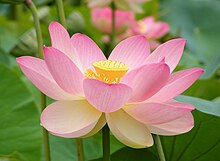Nelumbonaceae
| Nelumbonaceae Temporal range:
| |
|---|---|

| |
| N. nucifera (sacred lotus) | |
| Scientific classification | |
| Kingdom: | Plantae |
| Clade: | Tracheophytes |
| Clade: | Angiosperms |
| Clade: | Eudicots |
| Order: | Proteales |
| Family: | Nelumbonaceae A.Rich.[1] |
| Genera | |
Nelumbonaceae is a family of aquatic flowering plants. Nelumbo is the sole extant genus, containing Nelumbo lutea, native to North America, and Nelumbo nucifera, widespread in Asia.[2] At least five other genera, Nelumbites, Exnelumbites, Paleonelumbo, Nelumbago, and Notocyamus[3][4] are known from fossils.
Nelumbonaceae were once included in the waterlily family, Nymphaeaceae. Genetic analysis determined that the similarities between the families are an example of convergent evolution. Nelumbonaceae are highly modified eudicots belonging to the order Proteales, their closest living relatives being the plane trees (Platanaceae) and Proteaceae.[5] Notocyamus from the Early Cretaceous of Brazil is the oldest known representative of the family, and displays several transitional traits between Nelumbonaceae and both the Proteaceae and Platanaceae.[4]
The
See also
References
- ^ ISSN 0024-4074.
- ^ "Classification | USDA PLANTS".
- S2CID 86589995
- ^ ISSN 2045-2322.
- ^ Stevens, P.F. (2001 onwards), "Proteales: Nelumbonaceae", Angiosperm Phylogeny Website, retrieved 2014-02-25
- hdl:10654/18083
External links
 Media related to Nelumbonaceae at Wikimedia Commons
Media related to Nelumbonaceae at Wikimedia Commons- links at CSDL
